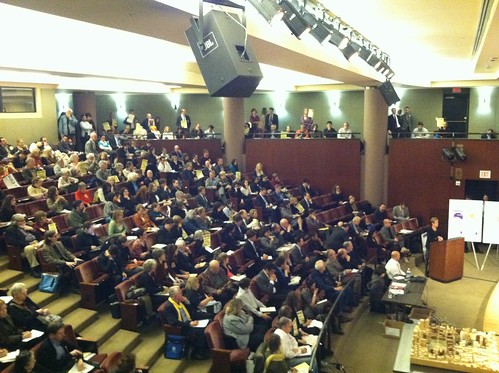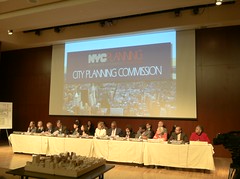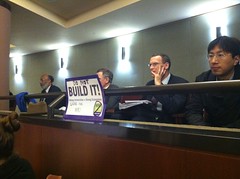Critics and supporters of N.Y.U.’s planned expansion in Greenwich Village pleaded their cases before the New York City Planning Commission yesterday. The exchange was a critical one, since the controversial project must be approved by the Commission and then by the City Council before construction can begin.
For more than seven hours at the Smithsonian Museum of the American Indian, speakers gave three-minute testimonies in response to the university’s pending build-out of the school’s core campus south of Washington Square Park. With the museum’s stadium-style seating filled to capacity, President John Sexton faced hissing and intentional coughing as he explained why the university was in “desperate” need of additional space, and why so much of it needed to be located in Greenwich Village.
“The heart of the matter,” he told the Commissioners, “is we are deeply compressed and the ratio of student to faculty needs to be adjusted upward.” He pointed out that N.Y.U. has 50 percent less space per capita than its peer to the north, Columbia University. The university currently leases, rather than owns, 2,500 student beds: the new plan would provide university-owned housing for over 1,000 more students.
“We’re committed to doing as much as can be done outside the core,” said President Sexton, who told the Commission that the university has already added 400,000 square feet of new space in Brooklyn since 2006. “But proximity is important for the activities that we’re putting in the core.”
When President Sexton claimed that N.Y.U. would maintain access to playgrounds throughout the 20-year build-out, the parent of a schoolgirl shouted, “My daughter doesn’t believe you! No one believes you!” He then took his child’s hand to thrust her protest sign high in the air. Both walked out to applause.
But Columbia University President Lee Bollinger urged the Commission to support the plan when it votes on the matter in mid-June. “Having been through this process ourselves at Columbia, we know first hand the competing interests to serve the greater good of the community,” he said, before going on to issue his closing argument: “It is very important that N.Y.U. be able to expand.”
Others, including State Senator Tom Duane, argued that N.Y.U. was poised to displace community resources and diminish quality of life. “I can barely describe how concerned I am about proposed development and its impacts on a neighborhood that we love and that N.Y.U. loves,” said the senator. Referring to two city-controlled strips along Mercer Street and LaGuardia Place that N.Y.U. would use during construction, he added, “Open space is so important and to take it away is just wrong.”
Ann Pettibone, a Greenwich Village resident of more than 40 years, said that new buildings proposed by the university would further diminish open space. The plan “ignores the original urban design intention” of Washington Square Village, she said. “N.Y.U. would rather turn Greenwich Village into Murray Hill.”
Students also spoke out in opposition of the plan. Peter Wirzbicki, a P.h.D. candidate in U.S. History, said that President Sexton’s concern about lack of space overlooked a more serious problem. “Space is not a moral issue, it’s an inconvenience,” said Mr. Wirzbicki. The university’s steep tuition rates, on the other hand, and crushing student debt, he explained, were far graver issues – especially when it is expecting to undertake an exorbitantly priced expansion.
Commissioner Anna Levin pressed David McLaughlin, the Provost of N.Y.U., about how the university planned to pay for such an expansive project. Mr. McLaughlin cited two kinds of funds: philanthropy and borrowed money. “As you pay off some debt, you’re able to replace that debt over the next decade,” he said. When pressed to break down how much of the project would be paid for with borrowed money and how much with philanthropy, Mr. McLaughlin said he personally could not provide that information, but claimed that it was known.
Part of the frustration voiced by those opposed to N.Y.U. 2031 stemmed from a sense that the University had been neither transparent nor willing to have an open dialogue with the community as it solidified its plans.
Brad Hoylman, Chairman of Community Board 2 – which represents Greenwich Village – told the Commission that since 2006, the board had held 50 meetings and 23 public hearings on the expansion. But the university, he claimed, did not reach out to them. “I cannot name a single individual not affiliated with the university from the local community who supports the proposal before you today,” he said, going on to explain that the density that would be added to Greenwich would “forever alter the character of this special neighborhood” and would change its residential character to non-residential use. Furthermore, he added, it would create “newly designed public spaces, designed without public consultation.”
“We are pleased that N.Y.U. has made its first concessions,” said Mr. Hoylman, referring to Borough President Scott Stringer’s joint plan with N.Y.U. to reduce its proposal, “therefore we’re hopeful more can be done.”
But others who spoke in favor of the plan repeatedly raised the need for improved and expanded academic space. Gérard Ben Arous, a professor of math at N.Y.U. said his classrooms at 9 p.m. were completely packed. And Mary Schmidt Campbell, the Dean of the Tisch School of Arts, said necessary performance spaces are currently unavailable in existing N.Y.U. buildings. The proposed academic space in the Zipper Building would relieve that crunch.
Perhaps more than any one side, the setting of the hearing highlighted without words the essential concern that brought the packed crowd out to the Museum of the American Indian. Jerry Ziman, a 45-year resident of the Village, pointed out the unspoken message. “It is ironic that we are standing in a shrine to one of the most beautiful and balanced cultures that we have ever destroyed,” said Mr. Ziman, addressing the Planning Commission. “We need mostly your recognition that [Greenwich Village] is an irreplaceable jewel.”






